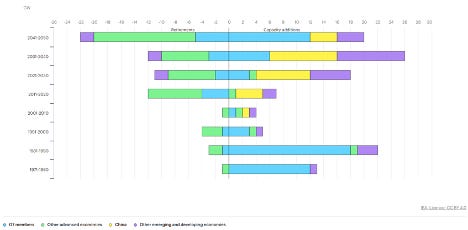A Whole (New) Nuclear World
A whole new world, a new fantastic source of power
Last week marked a significant moment for nuclear energy. Amazon announced its investment in small atomic reactors only two days after Google made a similar commitment. Microsoft had resurrected the Three Mile Island nuclear plant unit a month earlier.
Big tech is leading the sudden shift in the narrative surrounding nuclear energy, mainly due to the surge in energy demand from the AI boom. (see here about the power demand for AI infrastructure)
Nuclear energy has long been contentious, especially after Japan's Fukushima tragic disaster in 2011. Given their intermittent nature and dispatch ability limitations, nuclear energy could be the best carbon-free solution compared to solar, wind, and hydro.
Currently, nuclear power accounts for about 10% of global electricity generation but the International Energy Agency believes that it can play a crucial role in decarbonization efforts, especially for the G7 countries and China. With energy demand surging due to AI and EVs, the Department of Energy, data center expansion will drive electricity demand by 15-20% over the next decade in the U.S.
Source: World Economic Forum - IEA
Keeping the Grid Clean
In the US, new designs of small modular reactors (SMR) are garnering attention and support. SMRs are smaller nuclear reactors that are easier to build and could be the solution for clean energy of the future as coal plants are retiring across the country as part of the energy transition. CNBC reports that SMRs are perfect in replacing retired coal plants but the challenge is getting the first one built in the US. Currently, there are only three operating SMRs in the world, two are in China and one in Russia. Experts say the commercialization of the technology won't be able to happen until at least the 2030s.
On Oct 14, Google announced that it will purchase energy from Kairos Power SMRs, the deal will cover up to 500MW through 2035 which may involve six 75MW reactors and a potential 50MW demonstration project but the details of who will bear the cost is still unclear.
Source: International Atomic Energy Agency
Taiwan: TSMC’s Dilemma
And even Taiwan, home to the second most important AI player (after Nvidia) right now - TSCM, has said that Taiwan is open to nuclear technologies. Despite the fact that Taiwan once vowed to decommission nuclear plants after Japan’s Fukushima disaster, the Taiwanese Premier Cho Jung-tai recently said that “We hope that Taiwan can also catch up with global trends and new nuclear technologies,” adding that as long as there is a consensus within Taiwan on safety. A notable shift in attitude towards nuclear energy.
Taiwan has raised its electricty prices twice this year due to the AI boom that is also driving a surge in demand for chip companies such as TSMC. The chip maker reported earnings last week, emphasizing that power is one of their main cost items, as electricity prices have doubled in four years. TSMC is said to need to consume three nuclear reactors’ worth of power alone. So there are now talks about whether they’ll have to consider relocating the know-how and production to so called “friendly countries,” or Taiwan will need to find a cheaper alternative energy source - in this case, nuclear.
Japan: Creating a New Future
Japan, a country that has suffered the most due to accidents from nuclear power, is also reconsidering its stance. The country developed the research of nuclear power generation as early as the 1950s. The first commercial reactor went into operations in 1966.
In fact, before the terrifying tragedy that happened in Fukushima that was brought on by the Great East Japan Earthquake in 2011, 54 commercial nuclear reactors were in operation with a total generation capacity of 48,847 MW, and about 30% of electricity came from nuclear power in the nation, according to The Federation of Electric Power Companies of Japan. Following safety concerns, all nuclear reactors’ operations were shut down by 2012 across the nation.
While Japan has restarted some reactors since then, public sentiment remains cautious. The imminent need to utilize nuclear in the eyes of the government is also justifiable. Japan needs to import nearly 90% of its energy requirements.
Currently, the country has about 12 active nuclear plants according to the World Nuclear Association. But the issue has become a political talking point and the populist sentiment is against the reactivation of these plants, despite the reliance on nuclear power.
However with a new administration, Japan has restarted another active reactor, with many in the process of being rebooted once safety administrations are completed. The new economy minister said the country will maximize the use of existing nuclear plants due to AI and data center demands and as long as the reactors are safe, they will reboot them as soon as they can.
The recent investments by tech giants underscore a pivotal moment for nuclear energy as they are being thrust under the limelight again as governments and companies seek reliable sources of clean power amid escalating demands from AI and data centers. The climate benefit of nuclear energy is perceived to be outweighing the risks but the high cost in investment and human capital as well as potential geopolitical implications should not be completely ignored.
But as of now, as momentum has it, we may just be entering into a new world, a nuclear world.






